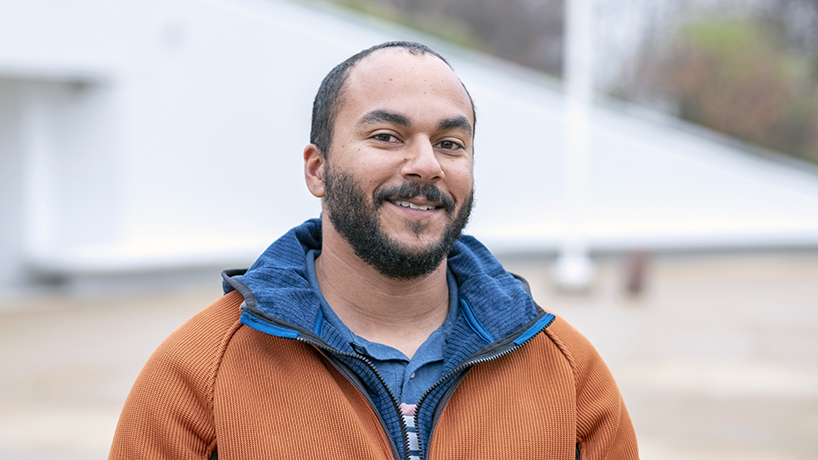
Civil engineering student John Gentilini is poised to graduate this month with a job at Civil Design, Inc. on its site development team. He comes to engineering after careers in the United States Army as a combat engineer then as a police office. (Photo by August Jennewein)
Breaking his finger changed John Gentilini’s life.
A police officer at the time, he’d been sidelined for two months while his injury healed. Left with little to do, Gentilini did what he always did with his free time: binge watch science programming.
“I couldn’t do other stuff like play video games, play my guitar, ride my motorcycle,” he said. “All I did for most of the day was just sit there and watch TV, and it was science-related stuff. So I said, ‘You know what, I’m going to change. I’m going to make science my career and get rid of the police department.’ That’s when I decided to go back to school.”
This fall, Gentilini makes good on that decision. He’s poised to graduate from the University of Missouri–St. Louis / Washington University in St. Louis Joint Undergraduate Engineering Program with a BS in civil engineering. Additionally, he’s moved on from police work, landing an internship and then a full-time position at Civil Design, Inc. on its site development team.
Gentilini’s path to engineering started before his broken finger.
He’d been interested in the sciences growing up, and one of his first dream jobs was to be a pilot. His father would sometimes take him to construction sites, and they’d watch buildings go up.
“But it was always a hobby,” he said. “I never thought of myself as going through engineering school, even though several of my friends did, right out of high school.”
Instead, after graduation, Gentilini enlisted in the United States Army. There he became a combat engineer, but he says there’s little resemblance to civilian engineering.
“There’s no math involved for the most part,” he said. “We build stuff. We tear stuff down, and we maybe blow it up. My primary mission was bridge building. We had our equipment with us. We would drive it wherever we went, and we carried our bridges with us.
“We would have to drive right alongside the infantry as they’re going into combat and build a bridge wherever they needed it. Or, if the bridge wasn’t needed, we would do other missions, like clear landmines, destroy fortifications. In Afghanistan, all we did was clear land mines, and dig up roadside bombs for the infantry. We were the first one to drive down the road in case the bomb exploded, so the infantry wouldn’t get hurt.”
Gentilini served from 1999 to 2007. He really enjoyed the experience, but when his contract was up, he decided not to reenlist.
He returned to civilian life in March and decided to apply to become a police office. Three weeks later, he was on the new job. He started as a regular patrolman and, over the course of his career, transitioned to training new officers.
Meanwhile, he’d come home from his shift and check out the Science Channel, YouTube or browse the internet.
“About construction, aeronautics and all that stuff, eight, nine hours, hours a day when I wasn’t doing any else,” Gentilini said. “That’s a lot of time.”
When it came time to decide just what type of program he was interested in, Gentilini became drawn to engineering because he was interested in designing and constructing buildings. When he discovered the UMSL/WUSTL Joint Program, the combination of affordability and quality seemed perfect.
First, he finished his associate degree at St. Louis Community College–Forest Park and then transitioned to UMSL. The workload increased gradually so it didn’t feel too intense, even though Gentilini continued working full time as a police officer as well as security at a bank, at Scottrade Center and then, starting in January, an internship at CDI.
“By the end of April, I was sick of it,” he said, explaining he’d left the police force in August.
Gentilini had been driving by CDI for ages and was drawn to the businesses’ name. Curious, one day he did some research and realized it was a good fit for what he hoped to do. The next day he drove by and chatted with the person at the first desk and dropped off his resume.
Several months later, he attended a meeting of the Engineers’ Club of St. Louis and started talking with its president – who turned out to be the owner of CDI.
“I talked to her a little bit, and she said, ‘Oh, yeah, I remember a police officer coming in one day,’” he said. “They called me back for an interview. In January, they hired me.
“It’s a diverse company. They have site design, surveying, structural engineering. They have water resources, and they also do traffic engineering. They’ve got an architect on staff and also do other labor type stuff. They’re contracted with Missouri American Water for water meter installations, and some other things. There’s a wide range of options there. They’ve done some fairly large projects, which interested me.”
Right now, he’s mostly working on hydraulic engineering with pipe sizes and stormwater runoff, which echoes some of his favorite studies: fluid dynamics, hydraulic engineering and mechanics of deformable bodies. He’d like to eventually work on the structural side, but for the moment is happy to be seeing the math he learned in school take form in the workplace.
Gentilini’s life has changed radically since that broken digit. On top of everything else, he got rid of his cable and no longer watches hours of Science Channel programming. But perhaps now his work will be featured on it one day.
“They show these huge overseas projects in the Middle East or in the North Atlantic, where they’re building a 40-mile-long bridge or something like that in the ocean,” he said. “I think that’s awesome. I want to be a part of it.”














